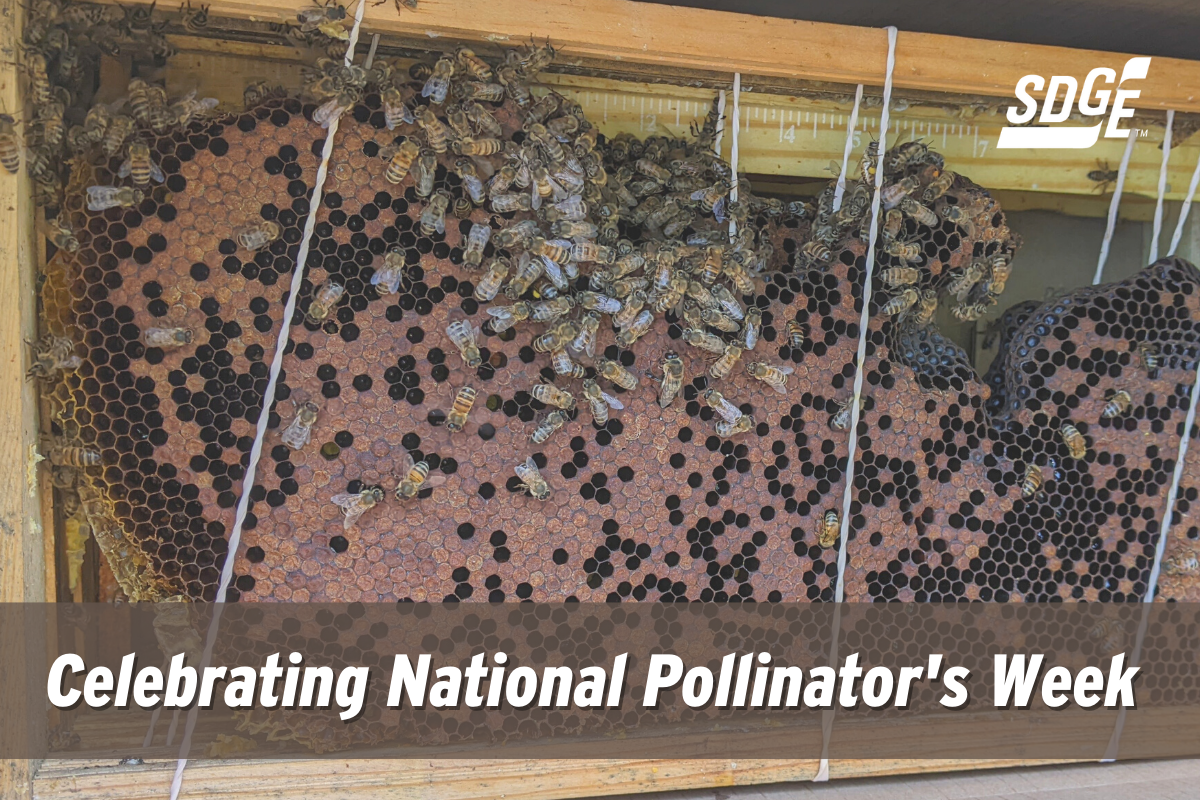June 20–26th marks National Pollinator’s Week – a time to raise awareness of the amazing benefits of pollinators and learn more about how we can support their health. At SDG&E, protecting our region’s biodiversity, which includes important pollinators like butterflies and bees, is something we do every day. In honor of the holiday, we are sharing an update on our Monarch butterfly and a new program to protect and relocate bees from SDG&E infrastructure and project sites.
Saving Bees
Did you know that San Diego County is home to more than 650 native bee species? That’s the highest amount of bee diversity for anywhere in the continental United States. That’s also good news for our region, as bees help pollinate native plants and food crops, which support our rich biodiversity. Unfortunately, that also means that some of these helpful insects make their homes at SDG&E project sites and facilities, causing safety challenges.
Understanding the important role that bees play in our local ecosystem, SDG&E Landscape Project Manager Bill Click sought a better way to help relocate these pollinators to more fertile feeding grounds. In 2021, Bill introduced SDG&E to We Save Bees, a local minority-owned small business that specializes in safely moving beehives. In the last year and a half, the We Save Bee team has helped relocate and/or rehabilitate hundreds of hives found by SDG&E personnel at project sites and within company infrastructure or facilities.
The process of relocating an active bee colony can take a few days. After first spotting bees, the team observes them for a day or two to make sure it is not just a bee swarm, but a hive. Once confirmed, We Save Bees sets up a replacement hive, typically made of cardboard, and loads it with enticements like sweet syrups, flowers, or even other bees, to encourage the colony to make this their new home. With all of the bees safely moved to the makeshift colony, the temporary hive is then transported to a more suitable location such as the avocado fields found throughout our region, where farmers welcome the helpful pollinators to their fields.
“One of the things I love about my work is finding new nature-based solutions to protect our special natural habitat here in San Diego,” said SDG&E Landscape Project Manager Bill Click. “What started as an experiment with relocating bees at our facilities, has turned into a new way for teams across the company to not only promote safety at work, but also support biodiversity in our communities – all while helping our local farmers and pollinators in the process.”
Helping Butterflies
In 2019, SDG&E signed on to the Mayor’s Monarch Pledge, a nationwide effort by the National Wildlife Federation to support the monarch butterfly by helping revive its natural habitat. The monarch butterfly population is declining rapidly. In the last 20 years, populations have fallen by 90%, putting this beautiful butterfly in danger of disappearing. As part of the pledge, SDG&E agreed to help bolster the monarch’s natural habitat by incorporating milkweed into our landscaped facilities, providing employees with plants for their yards at home and by promoting habitat and species education to the communities we serve.
Since taking the pledge, SDG&E has planted milkweed at its Century Park campus and is exploring ways to incorporate this plant in substation landscaping. The SDG&E Green Team hosted a presentation to employees on the importance of pollinators with Girl Next Door Honey, and SDG&E’s Environmental Champions grant program provides shareholder-funded grants to pollinator-friendly organizations such as Butterfly Farms, Resource Conservation District of Greater San Diego County, and Earth Discovery Institute to support community outreach and education events. Additionally, earlier this year, SDG&E launched a tree and plant rebate program that provides an incentive to customers who plant native trees and pollinator-friendly plants like milkweed at their home. More information on the Community Tree Rebate Program, including eligible plants and customer zip codes is available at sdge.com/tree-rebate.


